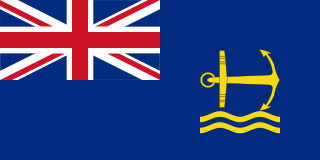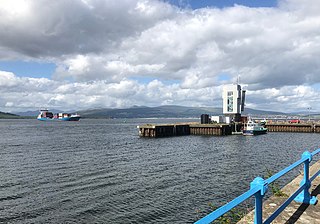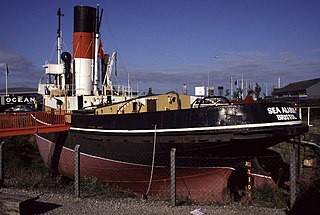
The Royal Navy (RN) is the United Kingdom's naval warfare force and a component of His Majesty's Naval Service. Although warships were used by English and Scottish kings from the early medieval period, the first major maritime engagements were fought in the Hundred Years' War against France. The modern Royal Navy traces its origins to the early 16th century; the oldest of the UK's armed services, it is consequently known as the Senior Service.

The Royal Maritime Auxiliary Service(RMAS) was a British Government agency which ran a variety of auxiliary vessels for His Majesty's Naval Service (incl. Royal Navy, Royal Marines) and the Royal Fleet Auxiliary. The service from 2009 has been run by Serco and is known as Serco Marine Services.

The Commander-in-Chief Fleet (CINCFLEET) was the admiral responsible for the operations of the ships, submarines and aircraft of the British Royal Navy from 1971 until April 2012. The post was subordinate to the First Sea Lord, the professional head of the Naval Service. In its last years, as the Navy shrank, more administrative responsibilities were added.

His Majesty's Naval Base, Clyde, primarily sited at Faslane on the Gare Loch, is one of three operating bases in the United Kingdom for the Royal Navy. It is the navy's headquarters in Scotland and is best known as the home of Britain's nuclear weapons, in the form of nuclear submarines armed with Trident missiles.

His Majesty's Naval Service is the United Kingdom's naval warfare and maritime service. It consists of the Royal Navy, Royal Marines, Royal Fleet Auxiliary, Royal Naval Reserve, Royal Marines Reserve and Naval Careers Service. The term Naval Service should be distinguished from the "UK Naval Services", which consist of the Naval Service and the Merchant Navy. The Naval Service as a whole falls under the command of the Navy Board, which is headed by the First Sea Lord. This position is currently held by Admiral Sir Ben Key. The Defence Council delegates administration of the Naval Service to the Admiralty Board, chaired by the Secretary of State for Defence.
SD Faithful is a Twin Tractor Unit Tug operated by Serco Marine Services in support of the United Kingdom's Naval Service. The ship was formerly operated by the Royal Maritime Auxiliary Service until its disbandment in March 2008. The vessel was originally built for the Royal Maritime Auxiliary Service in 1985.

The Royal Naval Auxiliary Service (RNXS) was a uniformed, unarmed, civilian volunteer service, administered and trained by the Royal Navy to operate in the ports and anchorages of the United Kingdom in an emergency. Although the abbreviated title would logically have been RNAS this abbreviation had long been taken by the various Royal Naval Air Stations, so RNXS it was. It maintained training units, and vessels at most major ports in the UK. and was formed in 1963 from the amalgamation of the Royal Naval Mine-watching Service (RNMWS) and Admiralty Ferry Crew Association in response to the perceived nuclear threat to British ports. The service was disbanded on 31 March 1994 due to Ministry of Defence (MOD) cuts. Most vessels from its fleet were transferred to the Royal Navy or sold, with the exception of XSV Loyal Volunteer, which was struck by a ro-ro ferry while berthed in Ipswich Harbour and was later scrapped.

The Tail of the Bank is the name given to the anchorage in the upper Firth of Clyde immediately North of Greenock, between Inverclyde and Argyll and Bute. This area of the Firth gets its name from the deep water immediately to the west of the sandbank which marks the entrance to the navigable channel up the Estuary of the River Clyde.

SD Salmoor was a Sal-Class mooring and salvage vessel working at HMNB Clyde, and based at Great Harbour, Greenock. She was originally operated by the Royal Maritime Auxiliary Service, but after the organisations disbandment in March 2008 she was operated by Serco Marine Services.

SD Colonel Templer is an acoustic research vessel, renamed Seaway Endeavour in 2011 after she was sold to a Swedish shipping company. Between 1980 and 2011, she was in the service of the Royal Aircraft Establishment, the Royal Maritime Auxiliary Service and Serco Marine Services in support of the United Kingdom's Naval Service. Before 1980, Colonel Templer was known as MV Criscilla and worked as a stern trawler.
DMS Maritime, formerly Defence Maritime Services, is a company providing port services to the Australian Defence Force and Marine Unit. It is a subsidiary of Serco.
NI Mário Ruivo, previously known as NI Mar Portugal, is a research vessel of the Portuguese Institute of the Sea and the Atmosphere (IPMA).

Admiralty tugs were tugboats built for and operated by the Royal Navy. These were vessels built to Admiralty specifications and in specific classes during the First and Second World Wars. They were built to meet the Royal Navy's demand for auxiliary vessels and to supplement the civilian tugs requisitioned by the Admiralty for war service.
Denholm Group is a British maritime company based in Glasgow, United Kingdom. It was founded by John Denholm of Greenock in 1866 and today has an annual turnover of over £250 million. It employs over 3,000 people around the world.
SD Atlas was a tugboat in service with Serco Marine Services at HMNB Portsmouth, where she worked in support of the United Kingdoms Naval Service.

SD Victoria is a worldwide support ship operated by Serco Marine Services in support of the United Kingdom's Naval Service, and currently the second largest ship operated by Serco Marine Services, after SD Northern River.
In 1989 the Royal Navy was under the direction of the Navy Department in the UK Ministry of Defence. It had two main commands, CINCFLEET and Naval Home Command.












